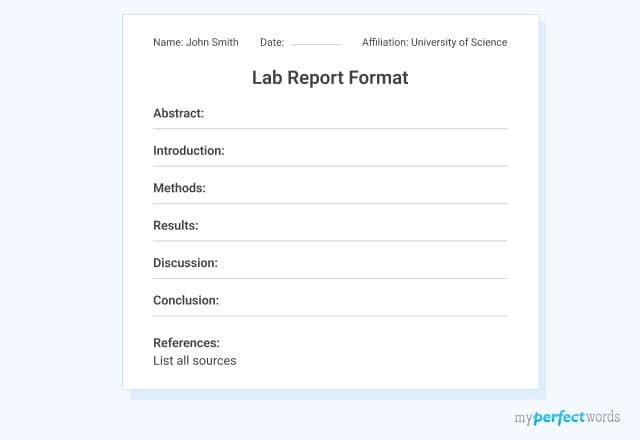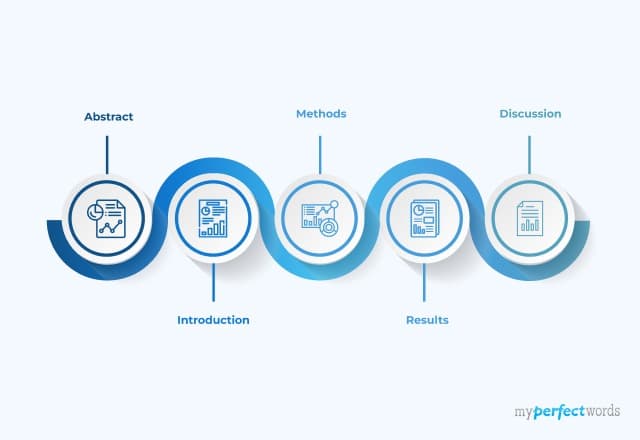

Have you ever stared at a blank screen, unsure of how to structure your lab report?
Many students and even seasoned researchers face this challenge. Crafting a well-organized lab report can be as daunting as the experiments themselves.
But worry not!
In this blog, we will learn how to format your lab report. We'll provide you with a step-by-step template, discussing crucial components. In addition we will also offer practical tips to ensure your lab reports shine.
So, without further delay let's get started!
On This Page![]()
- 1. Lab Report Format
- 2. Lab Report Outline
- 3. Lab Report Template
- 4. Lab Report Examples
- 5. Lab Report Formatting Tips
Lab Report Format
Here’s how to format your lab report:
Remember to adhere to any specific formatting requirements provided by your institution or publication guidelines.
Lab Report Outline
A well-structured lab report consists of several essential components, each serving a specific purpose in conveying the details of your experiment. These components are crucial for maintaining clarity, replicability, and scientific integrity.
In this section, we will dive into each of these components in detail.
Title Page
The title page serves as the first impression of your lab report. It should contain the following information:
- Title of the Report: A concise and informative title that accurately reflects the experiment's content.
- Author's Name: Your name or the names of all contributors to the report.
- Author's Affiliation: The institution or organization to which you are affiliated.
- Date of Experiment: The date when the experiment was conducted or completed.
Abstract
The abstract provides a brief but comprehensive summary of the entire lab report. Key points to consider:
- Summary: Summarize the experiment's objectives, methods, results, and conclusions.
- Conciseness: Keep it within 150-250 words, depending on your report's requirements.
- Clarity: Use clear and concise language, avoiding jargon.
- No References: Do not include references or detailed data in the abstract.
Introduction
The introduction sets the stage for your experiment by providing context and outlining its purpose. Key elements include:
- Research Question or Hypothesis: Clearly state the question you aim to answer or the hypothesis you intend to test.
- Background Information: Provide relevant background information, explaining why the experiment is necessary.
- Significance: Discuss the broader significance of the study within the field of research.
Methods
The methods section is a detailed account of how the experiment was conducted. It should act as a lab manual. Include the following in this section:
- Experimental design and Procedures: Describe the procedures step by step, so others can replicate your experiment.
- Equipment and Materials: List all equipment, materials, and chemicals used.
- Measurements and Observations: Document all measurements and observations made during the experiment.
- Controls: Mention any control groups or variables used to ensure the experiment's accuracy.
Results
In the results section, present the data collected during the experiment. Key considerations include:
- Data Presentation: Use tables, graphs, and figures to effectively present your findings.
- Completeness: Include all relevant data, even if it seems insignificant.
- Labels and Captions: Label figures and tables with informative titles and captions.
Discussion
The discussion section is where you interpret the results, draw conclusions, and consider the implications of your findings. Key elements include:
- Data Analysis: Analyze and interpret the data, discussing any patterns, trends, or anomalies.
- Addressing the Research Question: Explain how your findings relate to the research question or hypothesis.
- Comparison to Previous Research: Compare your results to existing research if applicable.
- Limitations: Acknowledge any limitations or sources of experimental error.
Conclusion
The conclusion summarizes the key findings and their significance. Elements to include:
- Key Findings: Summarize the main results in a clear and concise manner.
- Relevance: Restate the significance of the findings within the context of the research.
- Future Directions: Suggest potential areas for future research based on your findings.
References
List all the sources, including books, articles, and online resources, that you cited in your lab report. Follow a specific citation style (e.g., APA, MLA, Chicago) as required.
Appendices (if needed)
Include any supplementary material that is not part of the main report but may be relevant. This can include raw data, calculations, or additional information.
By including these components in your lab report and following the guidelines you ensure that your report is well-organized.
Lab Report Template
The lab report template simplifies lab report creation by offering structured sections and guidelines for clear communication. It serves as a handy reference for formatting and can be utilized by both students and researchers.
Let’s take a look at the template:
Lab Report Examples
Writing a lab report is simple if you know the basic writing techniques. It is essential to make sure that the lab report should be readable and understandable by the people from the other fields as well. So use simple language and clear representation of ideas.
To understand how a perfect lab report should look, we have gathered and presented some examples below. Follow these examples to write your report.
The above given examples will give you an idea about the structure and formation of your lab report.
Lab Report Formatting Tips
Here are some lab report formatting tips:
- Sharp Headings: Craft descriptive and sharp headings for each section to guide your reader.
- Chart Clarity: Use clear charts, graphs, and tables to visually represent your data.
- Reference Right: Master citation styles (e.g., APA, MLA) to properly credit your sources.
- Polish & Proof: Vigilantly polish your work for grammar, spelling, and punctuation errors.
- Trim the Fat: Be concise and ditch unnecessary jargon or filler content.
- Appendices Wisely: If needed, place supplementary materials wisely in appendices.
- Peer Feedback: Seek input from peers or mentors for valuable improvements.
- Logical Flow: Ensure a logical sequence from introduction to conclusion.
- Stick to Rules: Adhere to your institution's specific formatting rules for precision.
Summing it Up!
In academic writing, adhering to a precise format and structure is crucial. When tasked with crafting a lab report, it's essential to ensure it meets the required standards. In this blog, we've covered all the essentials for writing a solid lab report.
We understand, however, that formatting can sometimes be challenging and time-consuming. If you find yourself struggling and considering whether you should pay somebody to do my essay, remember that help is available.
Our expert writers at MyPerfectWords.com are here to assist you.
So if you’re facing difficulties in writing or formatting a lab report, simply contact our report writing service and let the professionals handle it for you.

Write Essay Within 60 Seconds!
Use our AI tool to generate high quality essay-18976.png&w=256&q=75&dpl=dpl_GPBTQ81QWKukLBiP8kV5QyX2m3jE)
WRITTEN BY
Amanda M.
Columbia journalism grad writing speeches. I craft clear, quotable messages for media moments.

